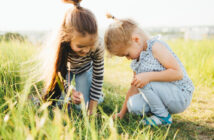
Professor Teresa Cremin
There is no blueprint for reading aloud, but these simple steps from Professor Teresa Cremin will help you relax and enjoy the special time that is sharing a book with your child. She says: “Reading aloud not only nurtures children’s pleasure in reading, it offers them models of how a book should sound and feel, helping them develop expressive reading in their own heads. Reading aloud to young children prompts them to listen actively and process more challenging texts and vocabulary than they could possibly achieve on their own”.
So settle down with your child, find a great book and take your time exploring it together. Here’s seven steps you can take to make reading aloud a really valuable experience:
1. Find a brilliant book
Quality picture books lend themselves to reading aloud to young children. They often have rich rhythms and rhymes, stunning illustrations and engaging characters with whom we can all connect. It’s worth the hunt – at school, the library or local bookshop and involving your child in choosing too. If there’s time try and read it to yourself first so you know how it flows.
Some of my favourites to read aloud to young children are:
– Shark in the Park, by Nick Sharratt
– We’re Going on a Bear Hunt, by Michael Rosen and Helen Oxenbury
– Oi Dog! by Kes and Claire Gray
– There’s a Bear on my Chair, by Ross Collins
– Dogger, by Shirley Hughes
– Can’t you Sleep Little Bear, by Martin Waddell
2. Choose a comfy spot
Turn off the TV and your phone and settle down together, perhaps with your child’s favourite cuddly toy to listen in too! It is often said readers are raised on their parents’ laps, so get comfortable and hold the book so you can both see it. This is your special time together.
3. Begin the journey
Read the title aloud and the author’s name and spend some time just looking together at the cover together, you might point things out, wonder aloud what’s going to happen to a particular character but let your child comment too. If you wish read the back cover blurb too, tempting your child with the snippets offered and chatting about what the book appears to be about.

4. Read, relax and respond
Open it up unhurriedly and begin to read the first few pages of the text, reading slowly and expressively before you pause, so you’ve begun to tempt your child in to the tale. Relax; there is no right way to do this! Being responsive to your child’s reactions is important. If they comment, ask questions or are looking closely at a picture, pause and respond, their relaxed attentive involvement is a joy to see and deserves your encouragement.
5. Blether about the book
Informal book blether is key to enjoying a story. Pause between reading it aloud and take the time to chat about what’s happening, the behaviour of the characters, what might happen next and so on. Make connections to people and events in your child’s life as this will help them make personal sense of the story.
Far from being a one-sided experience, reading aloud should be interactive – packed with young children’s observations, responses to the text and significant book blether.
6. Bring the book to life
Don’t rush, but do keep the flow of the story going (there will be plenty of time to examine it further on a 2nd/3rd reading!), so whilst at times you’ll stop to chat, at others, hold the telling space and have fun! Add in noises, emphasis, intonation and colour by using your voice to bring the book to life. No-one is watching and your child will enjoy it more and join in with your actions, facial expressions and any repeating lines.
7. Finish with space to think
As you reach the last page, slow down and let the story reach its end with emphasis. Then pause, looking intently at the page yourself to think about the tale, don’t rush to asking questions, allow some thinking space and let your child guide you. They may choose to look back through it, may demand it ‘again!’ or may scramble down in search of another. There’s no need to discuss it, but if they’re looking through it they may want to talk more about it.
Find out more:
For more ideas on supporting children’s pleasure in reading take a look at the OU’s reading for pleasure website
Study English Literature with The Open University
Explore literature resources and free courses on OpenLearn
Professor Cremin writes about how teachers can get children writing.
Storytelling in Early Childhood, a book edited by Professor Cremin et al, has won the UK Literacy Association Academic Book of the Year 2018. The judges said it ” makes a distinctive contribution to literacy education, inspiring the teaching of literacy and encouraging teachers to be reflective, innovative and creative.”



